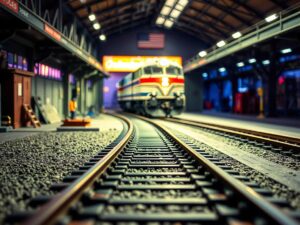
DCC vs. Analog Control: Which is Better for Your HO Scale Layout?
All aboard! When it comes to controlling your HO scale model trains, the choice between Digital Command Control (DCC) and Analog (DC) control is a significant one. Let’s break down the pros and cons of each to help you decide which is best for your layout.
DCC vs. Analog: A Quick Overview
DCC uses digital signals to control individual trains, allowing for multiple trains on the same track. It offers advanced features like sound, lighting, and automation.
Analog (DC) control uses track voltage to control a single train. It’s simpler but more limited in its capabilities.
Pros and Cons of DCC
| Pros | Cons | Best Suited for | |
| DCC (Digital) | Multi-train operation: Control multiple trains on the same track without interference. | Higher upfront cost: DCC systems can be more expensive than analog setups. | Larger, more complex layouts with multiple trains or advanced features. |
| Enhanced realism: Add features like sound, lighting, and realistic locomotive behavior. | More complex setup: Installation and programming can be more involved. | ||
| Automation: Automate operations like switching, signals, and train schedules. | |||
| DC (Analog) | Simplicity: Easier to set up and understand for beginners. | Limited to one train per block: Can’t operate multiple trains on the same track segment. | Smaller, simpler layouts with a single train or limited budget. |
| Lower cost: Generally more affordable than DCC systems. | Fewer customization options: Limited features compared to DCC. |
Cost Comparison
While the initial investment for DCC is higher, the long-term costs can be comparable. DCC systems often require upgrades, decoders, and accessories, while analog systems may need transformers and additional wiring.
Performance and Expandability
DCC is highly scalable and can easily accommodate larger layouts and more trains. Analog control is more limited, especially when it comes to multi-train operation and advanced features.
Which System is Best for You?
Consider these factors when making your decision:
- Layout size: Larger layouts benefit from DCC’s flexibility.
- Number of trains: If you plan to operate multiple trains, DCC is essential.
- Budget: DCC can be more expensive upfront, but it may be worth the investment for long-term benefits.
- Personal preference: Consider your comfort level with technology and your desire for advanced features.
Switching from Analog to DCC
If you’re transitioning from analog to DCC, you’ll need to retrofit your existing locomotives with decoders and may need to rewire your track. The process can be time-consuming but rewarding.
In conclusion, choosing between DCC and analog control depends on your layout’s complexity, your budget, and your goals as a hobbyist. DCC offers superior flexibility and realism, but analog control may be sufficient for smaller, simpler layouts.








